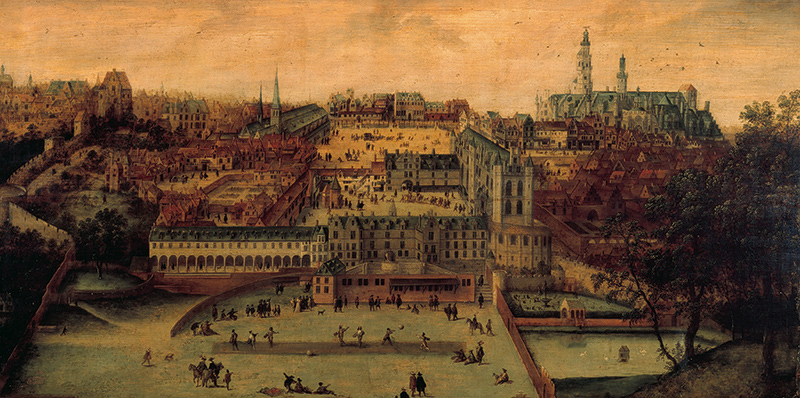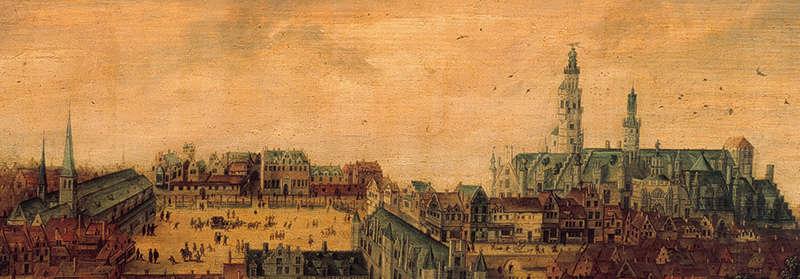
Oil on wood. Attributed to Lucas Gassel. 1540s
This bird's-eye representation provides us with the oldest complete image of the former palace of the Dukes of Brabant. The view is from the gardens situated to the north.
Origins
The Counts of Louvain, who would take the title of Dukes of Brabant, took up their residence on Coudenberg hill in the 12th century. In so doing, they asserted their authority over Brussels and its region, which they had controlled since the previous century. From the second half of the 14th century onwards, the fortified castle made way for a recreational and governmental palace. When the Dukes of Burgundy inherited the Duchy of Brabant in 1430, the palace was enlarged and embellished on their behalf, at the City of Brussels' expense. As such, they were willing to make it their principal residence. Brussels then became the de facto capital of all the principalities which the Dukes of Burgundy had managed to regroup under their authority, and which was referred to as the Low Countries. The Habsburg family subsequently inherited this territorial area. At the time this painting was produced, the reigning sovereign was none other than Charles V, who regularly stayed at his Brussels Palace.
The palace in 1540
The palace has 4 wings which are organised around a central courtyard.
 Opening onto the gardens, the residential wing shown in the foreground is illuminated by numerous windows, and is several floors high. The substructure of the section to the right corresponds with the walls of the former mediaeval castle, whose dimensions were somewhat compact.
Opening onto the gardens, the residential wing shown in the foreground is illuminated by numerous windows, and is several floors high. The substructure of the section to the right corresponds with the walls of the former mediaeval castle, whose dimensions were somewhat compact.
 To the left, a long building added in the 16th century is situated above a gallery which is perfect for strolling.
To the left, a long building added in the 16th century is situated above a gallery which is perfect for strolling.
 To the right can be seen the first two levels of the new chapel of the palace which, pending completion, is covered with a temporary roof.
To the right can be seen the first two levels of the new chapel of the palace which, pending completion, is covered with a temporary roof.
 To the rear of the chapel, an imposing building interspersed with turrets dominates the entire palatial complex. On the ground floor, it houses the large reception room which was built in the 15th century and referred to as the Aula Magna. On the other sides of the inner courtyard are the outbuildings and the conciergerie.
To the rear of the chapel, an imposing building interspersed with turrets dominates the entire palatial complex. On the ground floor, it houses the large reception room which was built in the 15th century and referred to as the Aula Magna. On the other sides of the inner courtyard are the outbuildings and the conciergerie.
The surroundings

A vaulted passage connects the inner courtyard of the palace with the Place des Bailles, which can be seen in the foreground of the painting. This enclosed public square is surrounded by the former church of Saint-Jacques-sur-Coudenberg. The neighbouring districts are occupied by half-timbered or brick bourgeois houses, as well as several aristocratic mansions. The most imposing of which, visible in the background to the right and recognisable by its two high towers, belonged to the Nassau family.
The gardens

In the foreground of the painting, the gardens of the palace are structured into separate spaces. In the centre, a large expanse was used for jousting, and later for the 'Jeu de Paume', as evidenced by the scene painted over in the 17th century, when tournaments had become passé. To the right can be seen a flower garden and a pond, both of which are enclosed. As for the wooded mound rising in the front right of the painting, it depicts the vast wooded area of the estate, referred to as the "warande". This game reserve with its uneven topography allowed the occupants of the palace and their guests to indulge in hunting.
The location of the current Royal quarter
On the abdication of Charles V in 1555, the sovereignty of the Low Countries passed to his son Philip II who inaugurated the Spanish branch of the House of Habsburg. Brussels Palace was henceforth no longer occupied in person by the sovereign, but by a governor or lady governor representing him. Under the reign of Philip II, a terrifying civil war broke out, coupled with a war of religion, which resulted in the secession of the Northern Netherlands, who proclaimed their independence. Thereafter, Brussels was only the de facto capital of the Southern Netherlands, which remained under the sovereignty of the Spanish Habsburgs. In 1715, following a crisis of succession which was resolved by a treaty, the Southern Netherlands fell into the hands of the Austrian branch of the House of Habsburg. It was under this government that the Brussels Palace was accidentally destroyed in 1731 by a devastating fire.

The ruins were only cleared in the 1770s-1780s. A comprehensive and innovative urban programme was then undertaken to completely reconvert the site of the former palace and its surroundings. The Place Royale was completed and a totally new quarter was built around a public park for the aristocratic and bourgeois elites.

Consequently, the present-day Brussels Park is located on part of the gardens and hunting reserve attached to the former palace.
Next step
Continue your visit round the section dedicated to the city and water. On the panel on the right, various documents illustrate the importance of canals in Brussels.




